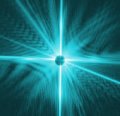 A 25 femtosecond snapshot of a stick man is all that was needed to prove that a new free-electron laser technique would work. Unfortunately, the poor old stick man evaporated within that split second into a 60,000 degree plasma.
A 25 femtosecond snapshot of a stick man is all that was needed to prove that a new free-electron laser technique would work. Unfortunately, the poor old stick man evaporated within that split second into a 60,000 degree plasma.
Theory suggested that researchers might be able to obtain a single diffraction pattern from a large macromolecule, a virus, or even a cell using a suitably short and bright burst of X-rays from such a free-electron laser. Only a single set of data would be possible because the sample would be fried by this pulse. Now an international team has demonstrated that the technique works. Their results will mean that biologists might be able to obtain crystal structures from complex molecules, such as proteins, without even having to crystallise them first. They can just blast a sample with an X-ray pulse and get almost all the data they need.
You can grab the full story in my regular techy news round-up on SpectroscopyNOW.com
Read on…